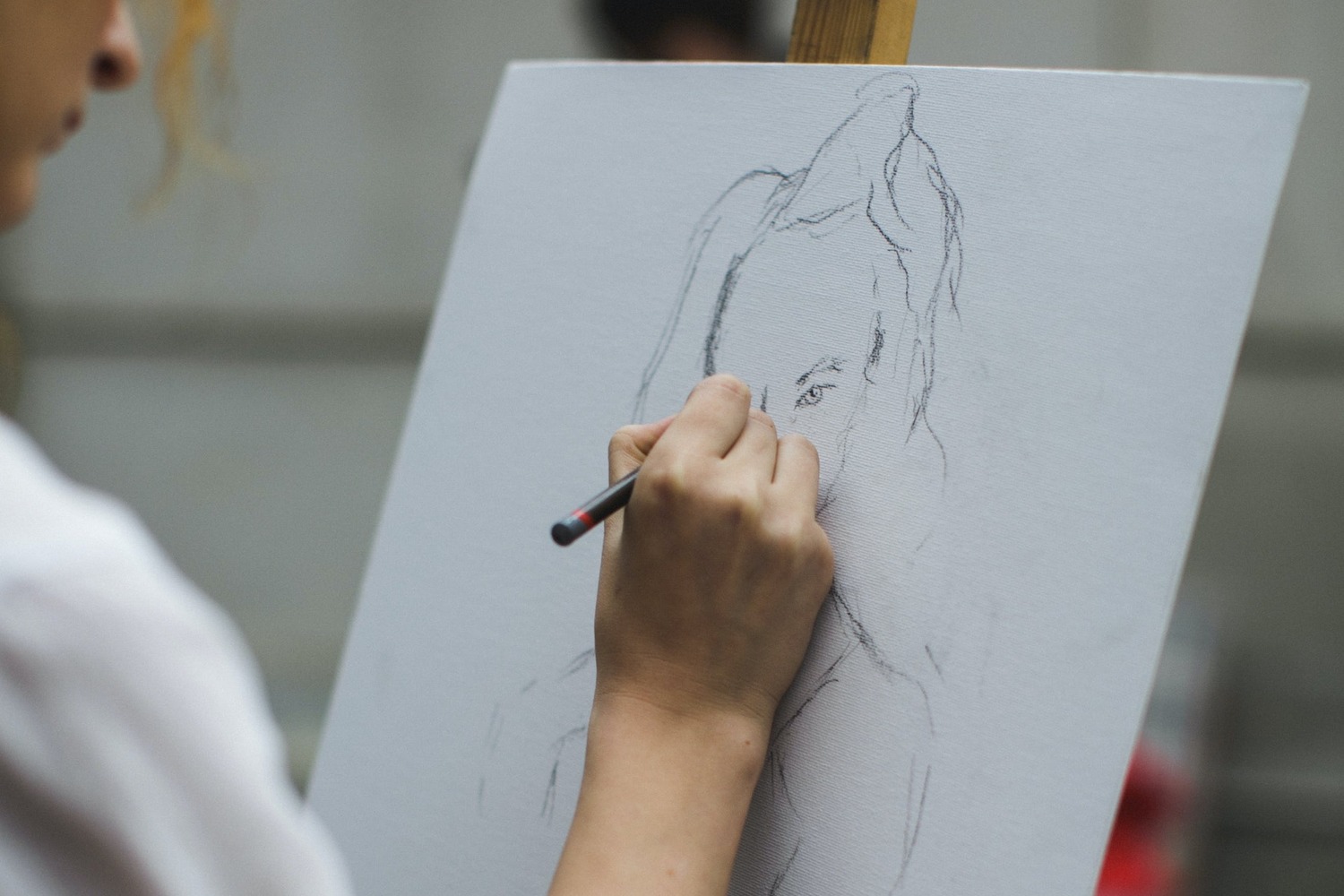
How to Draw in a More Realistic Style: A Simple Guide
Heads up: This post may contain affiliate links, Learn more.
Drawing Realistically: The Best Tips For Beginner Artists
Realism is one of the most impressive forms of art, which is why plenty of artists take up the style. It’s particularly hard to perfect and takes a significant amount of practice, but here’s beginners can start learning how to draw realistic art straight away.

What makes a realistic drawing?
There are many different styles of drawing, from Abstract to Photorealism. A drawing that is “realistic” looks as close to the real-life subject as possible. The key difference when making a drawing look realistic is the addition of impeccable detail, which can be a very time-consuming process. When you see other artist’s realistic drawings, it may look impossibly difficult to achieve, but it just takes practice and a lot of patience.
In a world where we can take a high-quality photograph with one click, it can feel fairly futile to spend hours painstakingly drawing to try to achieve something of the same realism. However, there is something quite compelling about paying such close attention to the details of an ordinary subject. This in turn gives the viewer a renewed appreciation of the fine detail in something that they may not usually look twice at. Realistic drawings show off the artist’s pure technical skill and ability to closely observe. There’s magic in creating the illusion of a machine-made photograph completely by hand.
How To Draw Realistic Art
Update your tools
Pencils
When trying to achieve realism in your drawing, it is important that you are equipped with the right tools. The main thing you will need is a good set of drawing pencils, rather than just one HB writing pencil. You will need to get a variety of different pencils with varying softness so that you can create different types of marks and shading.
Pencils might be the traditional tool used for realism, but consider practicing drawing with something that you cannot erase like a marker pen. This will force you to make more purposeful bold marks when working out the key shapes and forms of your subject.
Erasers
Erasers are not just useful for correcting mistakes. They can also be used to add areas of light. Kneaded erasers can be molded to whichever shape you need, so you can erase just a tiny spot at a time. You can also buy a blending stump or “tortillon” to help you smooth out your shading, instead of using your finger in small areas.
Paper
The type of paper you draw onto can also impact how the drawing looks. Different textures of paper may be more difficult to draw on – the smoother the paper the smoother your blending will be.You’ll also need to consider the paper size, with larger pieces taking considerably more time to complete. You can create a border with masking tape to peel off at the end, so you have a clean straight edge around your drawing. It is handy to have a scrap piece of tracing paper to rest your drawing hand on, so you don’t smudge your masterpiece.
Art supplies can be expensive, but once you’ve invested in some of the essential items, they should last a long time. To help save some money, many art shops offer student discounts, so it’s always worth checking that out.

Getting the basics right first
Before you even pick up your pencil, you should start by spending a lot of time looking at your subject, studying the different shapes, marks and lighting. Your “subject” is whatever you choose to draw, whether that’s a person, a landscape, or an object. Inspiration can be found anywhere and everywhere; the possibilities are endless.
However, when learning to draw realistic art, it might be useful to start with a fairly plain object that doesn’t have too much texture or detail. Perhaps the easiest thing to draw in a realistic style is a piece of fruit, like an apple. Then, you can move onto more complex subjects like animals or people. Try zooming in on specific parts at first, like one eye or lips in great detail.
Observe your Reference
To achieve realism, it’s important to constantly be looking at a reference throughout the drawing process. This could be a live set-up with objects or a model, or you could use a reference photograph. Some people argue that drawing from life is a better way to achieve realism, because a photograph can sometimes “flatten” your subject – but why not try both to figure out what works best for you.
Make sure there is a good light source shining on your subject, so that you can see where the light and shadows fall. If you are using a photograph, it is important that the contrast is strong. You can even edit your photo in GIMP or Photoshop and turn it into grayscale – this will help you to see where the light and dark is. Make sure your reference photograph has a high resolution, so that you can see all the fine details.

Getting an accurate initial sketch
Accuracy is the essential basis of a realistic drawing. Try planning your drawing out with a few rough sketches before starting on your final piece of paper. When you’re ready for your final drawing, think of the composition as a whole and map out the most prominent shapes, rather than the finer details initially.
For example, when drawing a person, try to sketch out the whole shape of their body, rather than starting from the top of their head in great detail. You might spend ages drawing a beautiful face only to realise it is placed in the wrong position compared to the rest of their body. You should draw your initial form very lightly, using little pressure on your pencil.
It is important to consider perspective to create a 3-dimensional shape, looking closely at how the shape changes depending how close or far away it is. For example, body parts may be slightly distorted depending on the way your model is lying, compared to if they were standing straight facing you.
Life drawing sessions are a great way to practice your observational drawing skills with a real-life subject, particularly if you want to draw people. It may be intimidating at first, but it’s useful to chat to other artists at the sessions to see how they might approach things differently.
You can use a grid to help you get the correct proportions if needed, particularly when using a photo reference.

Notice the Light
Light can be a defining factor when you’re learning how to draw realistic art. Adding the glint in someone’s eye can really make a portrait come to life. Look closely at the way the light hits your subject, noticing the highlights, light areas, middle tones and shadows. The highlights will be your brightest areas and the shadows the darkest, with lots of variation in between. You can practice by moving your light source around your subject, so that you become familiar with how light behaves from different angles.
Shadows are important to give your drawing that 3-dimensional realistic quality. Sometimes the shadows are very obvious, whilst other shadows are more subtle. The more complex the shape of your subject, the more shadows you will notice – a person’s face for example, will have a lot of different shadows, whereas an apple may just have one strong shadow.
Developing your drawing
Smooth Shading
Developing a smooth shading technique is very important if you are trying to make a drawing look realistic. Shading is used to create subtle transitions between light and dark areas using mid-tones.This is when your drawing pencil set will come in very handy. Practice is the best way to learn the proper pressure control when using your pencil for shading – the more pressure you use, the darker the mark will be.
Top tip: It is often better to have dull rather than sharp pencils to get smoother shading.
Thoroughly blending and smudging your shading is the best way to get a smooth, realistic effect. It is better to use a blending stump or some tissue paper instead of your finger, as your finger could transfer oils to the page.
Whilst it is important to make the transitions smooth, your drawing should still have a variety of tones. You don’t want your drawing to become a blur of grey. Make sure you maintain good contrast and range in your values – make your darks dark and your lights light.

Avoid Outlines
It might be tempting to outline the shapes you see, but defined outlines can make your drawing look more like a cartoon. When you actually look at your subject, you may notice that the shapes consist of smooth gradients rather than defined lines. For example, our faces are completely made up of bumps – our lips and eyes do not have a harsh outline around the edge. Focus on using shading at the edges of shapes to create a softer or harder edge.
Create Texture
Creating different textures in a drawing can be a challenging but fun part of the process. Each different texture can be created with different pencil marks, zooming in on specific sections. If you are drawing animals, the different kinds of fur, feathers or scales are vital to make your creature look realistic. When drawing people’s faces, adding the textures of wrinkles or pores on their skin will really make your drawing come to life. When drawing an eye, there are lots of textures to play with, from the glossiness of the eyeball to the hair of the eyelashes.
Conclusion on How to Draw Realistic Art
Learning how to draw realistic art can be challenging but also very rewarding when you manage to achieve that realistic likeness. Start out slow and try not to put pressure on the process.
Remember that a drawing does not necessarily need to look realistic in order to be “good”. Realism is just one style of drawing, but there are many ways to translate your observations onto paper. You could try out lots of different drawing styles and tools to see which feels the most natural to you.
NEED MORE ADVICE?
ARTICLES TO HELP:
7 Drawing Pencils For Beginners That You Need To Make Beautiful Art
The 7 Best Coloured Pencils That Every Artist Needs
The Best Shading Techniques Guide: 7 Simple Tips For Every Artist
SITES TO HELP:
Drawing – History, Techniques, Materials
COURSES TO HELP:
Learning To See: A Beginners Guide To Drawing Realism
Portrait Drawing For Beginners: How To Draw Faces Quickly And Accurately
Realistic Colour Pencil Drawing: Beginners Guide To Realism


